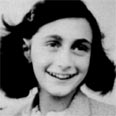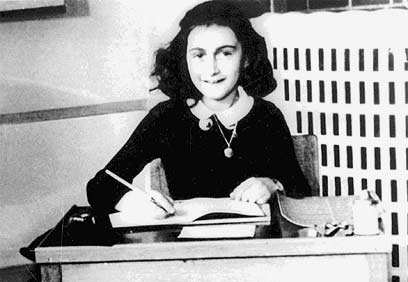
My cousin, Anne Frank
Bernard Elias, only living relative of Jewish girl who wrote famous Holocaust diary, believes that 'if she were alive today she would fight for human rights'
Elias, a European actor, was very close to his cousin Anne, who called him "Bernad", as a child. The two used to spend their vacations together at their grandmother's home in Basel and at the family's summer house in the mountains.
In one of the diary's pages, Anne mentioned her desire to go shopping in Switzerland with her beloved cousin Bernard. She even managed to compile a shopping list in case her father agreed to give her 150 gilden and let her buy the clothes she wanted.
She planned to buy three cotton vests for 50 cents each, three cotton underpants and a cardigan, and her imagination continues to ice skates, makeup, dresses and books.
Elias, 82, visited Israel recently with his wife Gertie for the Jerusalem International Book Fair, where he read segments from a new book about the Frank family. The book, "Greetings and Kisses to All", was edited after Gertie found more than 6,000 documents and letters belonging to the family in the attic of his parents' home.
It turns out that Anne was not the only one who knew and loved to write. "We were a family which wrote letters, and the letters reveal a very interesting picture of life in the 19th century and the early 20th century," he says.
Renewed acquaintance
Elias remembers the day he first received segments from the diary, which Otto, Anne's father, translated into German. "He would translate parts of it and send them to us in Basel," says Buddy, who read the diary as a whole only after it was published and translated into German.
"It was very exciting, and I could connect to the words of Otto, who said 'I did not know my daughter until I read the diary.' That's how I felt too. I knew Anne as a mischievous girl, even wild, funny and enthusiastic, and I never realized what deep thoughts this girl had inside of her, until I read what she wrote."
Elias was very moved when he found out that he was mentioned in the diary. "To this day I read segments from the diary, especially when I meet with schoolchildren, and every time I reach a place in which she mentions me it touches me once again."
Did everyone talk about her extraordinary talent during her childhood?
"She wasn't some whiz kid that everyone danced around and praised her talents. She was a cute, sportive girl, very creative, and she and I really liked each other and would play and run wild together. Margot, her older sister, who was my age, was a bookworm and preferred to stay home, but Anne and I loved to be outside, and when we vacationed at our summer house we would spend the entire day in the forest."

'She was usually a lot of fun to be with' (Photo: AP)
Even when the weather left them at home, Anne found creative ways to pass the time. "She loved to dress up and put on shows, and I also had a marionette theater at home, which she really liked to play with."
This is what they did in 1938, in what would later turn out to be their last meeting. "Margot, as always, sat by the window and read a book, but Anne and I played with my marionette theater. I had puppets of a grandmother, a crocodile and a clown, and I was responsible to operate them" says Buddy.
"According to the story, the crocodile wanted to eat grandma, but the clown arrived and killed him. Anne loved the story, but she didn't settle for the puppets. So she made me put on one of the grandmother's dresses, wear one of her hats and high heels and imitate her. I was an enthusiastic partner and did everything she asked me to, and Anne laughed. She had a great uproarious laughter."
Buddy remembers other moments too, when Anne was angry and would shout. "Like every child gets angry when they don't get what they want, but she was usually a lot of fun to be with."
When the vacation ended and the Frank family returned to its home in Amsterdam, the correspondence continued through many letters the families wrote to each other. "Otto Frank was the eldest brother of my mother, Lenny, and he wrote her many letters," says Buddy, who remembers how Anne used to tell him in her letters about school, her friends, hiking and ice skating.
"The letters revealed that they were living a good life. Nothing unusual," he says, "nothing that could predict what was about to happen."
Letters censored
When the Germans invaded Poland, the tone of the letters changed naturally. "They had to be very careful about what they wrote, because all the mail was subject to serious censorship," Buddy explains.
The Elias family learned from the letters about the new decrees against Holland's Jews, who were forced to arrive home before 8 pm and were forbidden to ride a bicycle on the street or use the tram. "They were definitely not allowed to go swimming or ice skating, and Anne loved to ice skate," says Buddy, who later on became a professional artistic skater.
"In one of the letters she told me that she dreamed this war would end already so she could go ice skating with me again." But instead, on July 5, 1942, a postcard arrived from Otto, who said they would not be able to write anymore for the time being that he hoped his sister understood. "We understood that they were going into hiding," says Elias.
The next time the Elias family received a sign of life from the Frank family was at the end of the war. Otto, who survived Auschwitz after the concentration camp was liberated by the Russians, was making his way back to Western Europe in a journey which lasted five whole months.
"We got a telegram from him through the Red Cross, saying he was on a ship on his way to Marseilles. During the trip from Poland back to Western Europe he already learned that his wife Edith had perished in Auschwitz, but he hoped his daughters had survived the war. A month later he heard that Margot and Anne had died of typhus in Bergen Belsen."
When Otto arrived in Amsterdam, he was met by Miep Gies, the woman who helped hide the family. She handed him the diary in which Anne documented the hiding period, from June 12, 1942 to August 1, 1944.
"This is Anne's legacy," Miep told him after keeping the diary in her drawer all those years with the hopes of returning it to Anne.
"It wasn't just the small booklet she received for her 13th birthday," says Buddy. "There were hundreds of pages and notes she wrote while in hiding."
If Anne had survived, what would she do for a living?
"If Anne were alive today, she would undoubtedly be a writer or a journalist, and a brave fighter for human rights."
The diary inspired dozens of theater and cinema productions, "not all of them very good," says Buddy. During a visit to Peru, he watched a production of "Anne Frank's Diary" with a dark-skinned and very fat girl playing the role of Anne. "It was simply ridiculous. A fat Anne!" he laughs.
And there were some who angered him, like British writer Sharon Dogar, who published a fictitious diary written by Peter van Pels, Anne's friend in hiding.
"Anne was not the child she is in this book. From what Otto told me about Peter, he was very shy, but in this book he is given a character he did not possess," Buddy told British media outlets which sought his response. "I also do not think that their terrible destiny should be used to invent some fictitious story."
Since 1996, Elias has been devoting his time to preserve Anne Frank's memory and heritage. "Someone once said that six million was statistics, but Anne Frank, one little girl, can symbolize that entire horrible period for millions of people worldwide, who in a different situation would know nothing about the Holocaust," says Elias.
Elias has not completely abandoned his acting career, and still performs in the theater from time to time. But most of his energy is devoted to his role as president of the Anne Frank Foundation in Switzerland. He is responsible for the funds received by the foundation from the book sales, productions and any use made of Anne's materials and pictures.
"All the money that enters the foundation is donated to charity organizations selected according to Anne's ideals," he explains. "This includes organizations whose goal is to further peace and unity between people, help children around the world and fight racism and anti-Semitism, because Anne's role as a symbol has not ended yet."
If Anne were alive today and aware of the acts of anti-Semitism and cruelty in the world, her cousin is convinced, she would definitely protest them openly.
He admits that he sometimes asks himself what Anne would have looked like had she survived the Holocaust. An 81-year-old woman with dark, glowing eyes. But this question remains unanswered, and Anne Frank will forever remain a 15-year-old girl who was just beginning to taste life.
- Follow Ynetnews on Facebook










